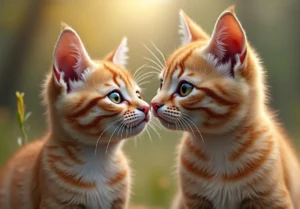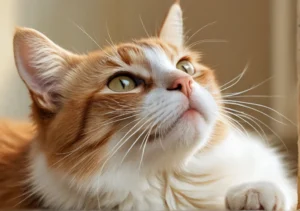Cats are known for their unpredictable behavior, and many cat owners have experienced the phenomenon known as the “crazy hour.” But why do cats have this sudden burst of energy and wild behavior? Let’s explore the reasons behind this common feline behavior.
Natural Instincts
Cats’ crazy hour can be attributed to their natural instincts. Cats are predators by nature, and even domesticated cats still retain some of their wild hunting instincts. During their crazy hour, you may notice your cat exhibiting behaviors like pouncing, chasing, and stalking imaginary prey. This behavior is a way for cats to mimic hunting, even if they are well-fed pets. Engaging in these instinctual behaviors can be mentally stimulating and satisfying for cats, fulfilling their innate need to hunt and play.
Energy Release
Cats use the crazy hour as a way to release pent-up energy and combat boredom. Just like humans need physical activity to stay healthy and happy, cats need to stay active to maintain their physical and mental well-being. The crazy hour may involve bursts of running, jumping, and playing, which helps cats burn off excess energy and stimulate their minds. Providing your cat with interactive toys, scratching posts, and opportunities for exploration can help channel their energy in a positive way.
Unique Insight: To help your cat unwind after their crazy hour, consider providing a cozy spot for them to rest. Cats often alternate between bursts of activity and long periods of sleep, so having a comfortable bed or cushioned area for them to relax after playtime can encourage healthy rest patterns.
Remember, the crazy hour is a normal and healthy behavior for cats. By understanding their natural instincts and energy release needs, you can support your feline friend in staying happy and active.
Circadian Rhythms
Did you know that cats have an internal clock just like humans do? Yep, it’s called their circadian rhythm, and it plays a big role in their crazy behavior during what we call the “crazy hour.” This special clock is what tells your furry friend when it’s time to be active and when it’s time to rest. For cats, their internal clocks often align with dawn and dusk, which might explain why they tend to go a little wild during these times. So, when you see your cat zooming around the house like a maniac, blame it on their circadian rhythm telling them it’s playtime!
Environmental Factors
Ah, the environment – a key player in your cat’s antics during the crazy hour. It’s not just their internal clock making them go bonkers; it’s also the world around them. Things like too much stimulation, stress, or even new stimuli can trigger your cat’s crazy behavior. Imagine if someone randomly turned on bright lights, played loud music, and threw a bunch of new toys at you all at once – you’d probably go a little crazy too! So, give your feline friend some space to chill out and recharge after their wild hour to keep them happy and healthy.
- Provide your cat with interactive toys to keep them entertained and mentally stimulated.
- Make sure your cat has plenty of hiding spots and perches to feel safe and secure.
- Create a calming environment with soothing music or pheromone diffusers to help reduce stress and anxiety.
- Stick to a consistent daily routine to help regulate your cat’s internal clock and reduce the chances of them going nuts during the crazy hour.
Remember, understanding your cat’s crazy hour is all about knowing their circadian rhythms and how their environment can affect their behavior. With a little love, patience, and some fun toys, you and your kitty can navigate the wild world of the crazy hour together!
Social Interaction
Cats can exhibit a crazy hour due to their need for social interaction. Just like humans, cats crave connection and playtime with others. Whether it’s frolicking with fellow feline friends or engaging in interactive play with their human companions, these interactions contribute to their overall well-being. Playing helps release excess energy and stimulate their minds, which can lead to those wild bursts of activity. So, make sure to carve out time for quality play sessions to keep your cat happy and engaged. Remember, a tired cat is a happy cat!
Health and Wellness
A cat’s crazy hour can also be influenced by their health and wellness. A well-balanced diet, regular exercise, and mental stimulation are crucial factors in maintaining a cat’s overall well-being. A lack of physical activity or mental enrichment can lead to pent-up energy, causing cats to act out during their crazy hour. Make sure your feline friend has access to engaging toys, scratching posts, and interactive play to help them stay active and mentally sharp. Additionally, scheduling regular veterinary check-ups to address any underlying health issues can also help curb those sudden bursts of energy.
Key Tips for Managing Your Cat’s Crazy Hour: 1. Provide plenty of interactive toys to keep them engaged. 2. Establish a routine for playtime to release excess energy. 3. Ensure your cat has plenty of vertical space to climb and explore. 4. Consider incorporating puzzle feeders to stimulate their minds. 5. Consult your vet if your cat’s crazy behavior seems excessive or concerning.
Remember, understanding the reasons behind your cat’s crazy hour can help you create a harmonious environment that meets their social, physical, and mental needs. By proactively addressing these factors, you can help your cat channel their energy in a positive and healthy way.
Tips for Managing
If your cat is having a crazy hour, there are a few strategies you can implement to help manage this behavior. First, make sure your cat has plenty of mental and physical stimulation throughout the day. This can include interactive toys, scratching posts, and designated playtime.
Additionally, create a consistent routine for your cat to help reduce stress and anxiety. Cats thrive on predictability, so feeding them at the same time each day and maintaining a regular sleep schedule can be beneficial.
If your cat’s crazy hour tends to involve destructive behavior, consider providing alternative outlets for their energy such as puzzle feeders or climbing trees. Redirecting their energy in a positive way can help prevent unwanted behaviors.
Finally, if your cat’s crazy hour occurs at a specific time of day, try to schedule play sessions just before this time to help release pent-up energy. With a little bit of structure and consistency, you can help manage your cat’s crazy hour effectively.
Fun Facts About Cat Behavior
Did you know that cats have a natural hunting instinct that drives their crazy behavior? Cats in the wild are most active during dawn and dusk, known as their “crepuscular” nature. This is why your cat may be more active and energetic during these times.
Another interesting fact is that cats have scent glands on their cheeks that they use to mark their territory. When your cat rubs their face against furniture or you, they are not only showing affection but also leaving their scent behind as a way to claim their space.
Cats also have a unique way of showing their excitement or stress through their tail movements. A twitching tail may indicate agitation, while a puffed-up tail suggests fear or aggression. Understanding these subtle cues can help you better interpret your cat’s behavior.
By incorporating these fun facts into your knowledge of cat behavior, you can gain a deeper understanding of why your feline friend acts the way they do.
Alex, a passionate animal lover, has experience in training and understanding animal behavior. As a proud pet parent to two dogs and three cats, he founded AnimalReport.net to share insights from animal experts and expand his knowledge of the animal kingdom.




